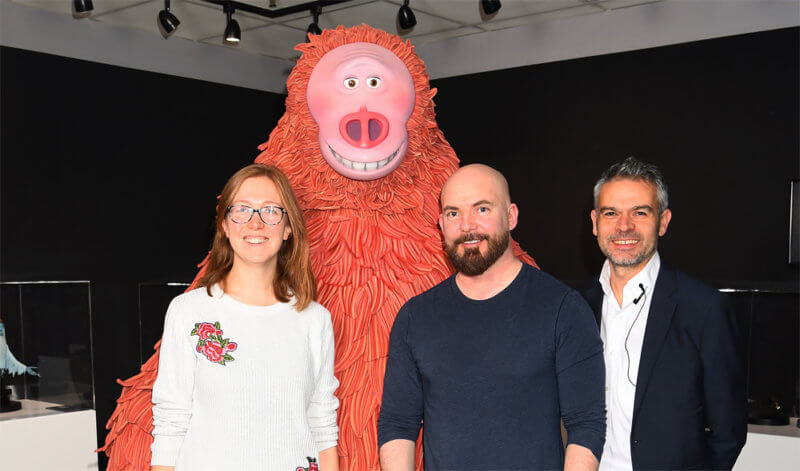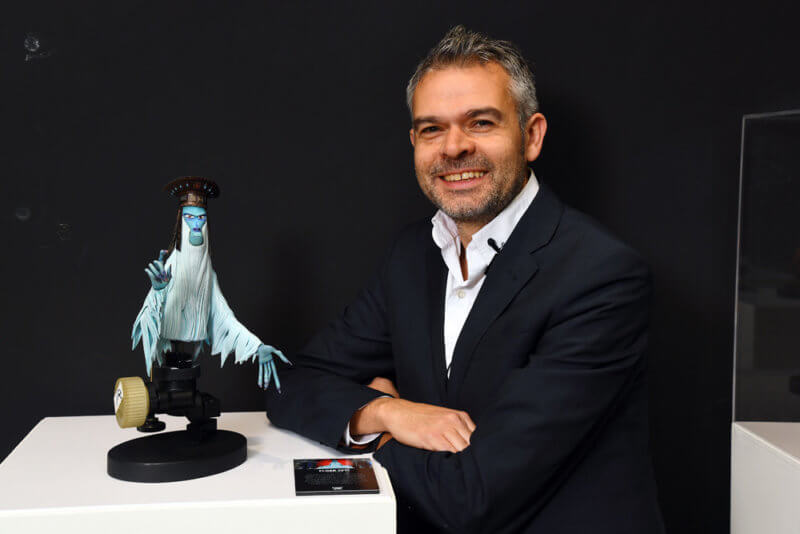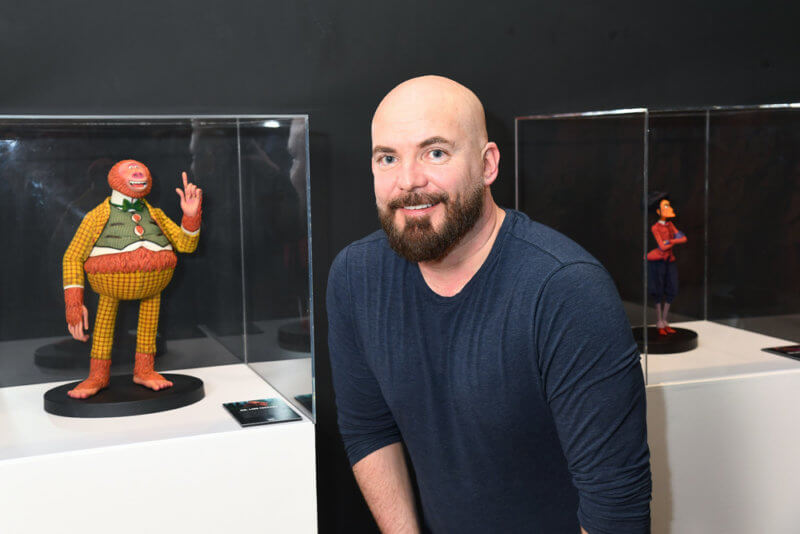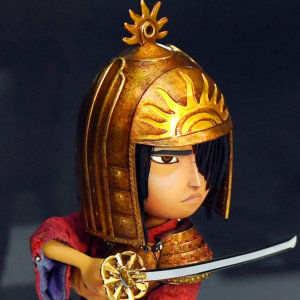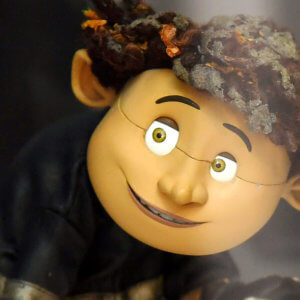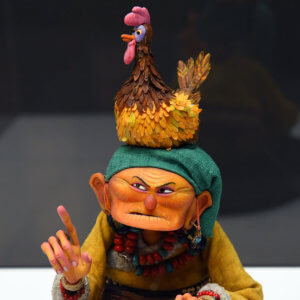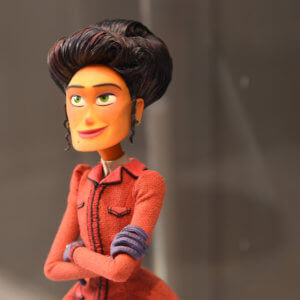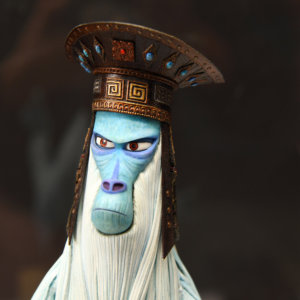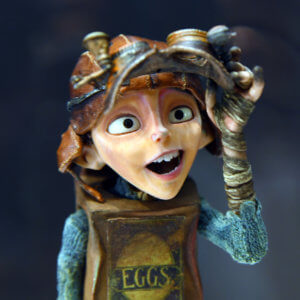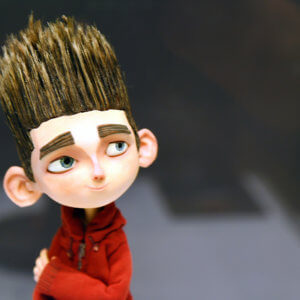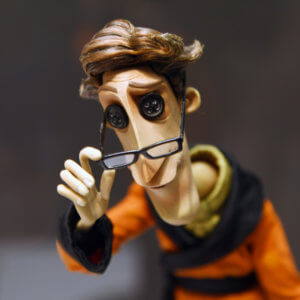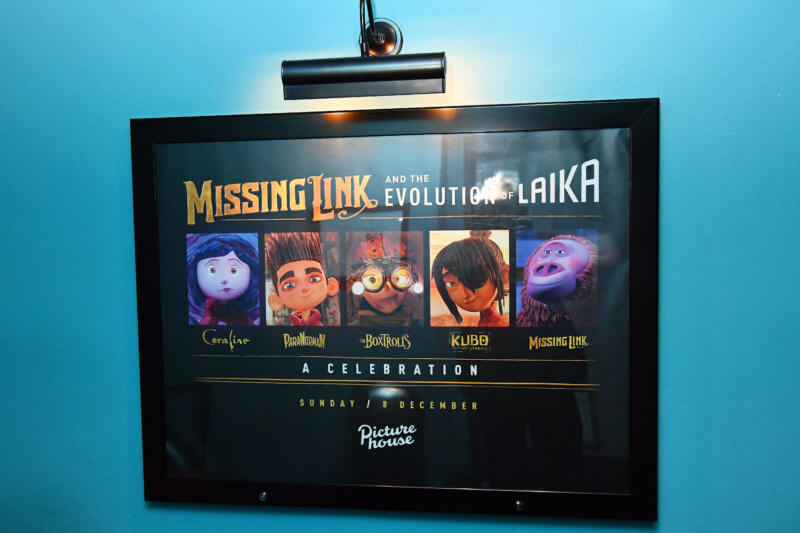The Evolution of LAIKA – Q&A with Chris Butler and Oliver Jones
On Sunday 8th December LAIKA and Picturehouse Central came together to present the special event Missing Link and the Evolution of LAIKA, a Retrospective of the studio’s films to date. As well as screening all of its major feature film releases – Coraline (2009), ParaNorman (2012), The Boxtrolls (2014), Kubo and the Two Strings (2016) and Missing Link (2019) – the event also featured onstage Q&As with Chris Butler (writer/director of Missing Link and ParaNorman) and Oliver Jones (Director of Practical Effects at LAIKA) as well as an exhibition of LAIKA puppets and dioramas at the venue.
On top of recently receiving eight Annie Award nominations, the studio’s latest stop-motion feature Missing Link is among the nominees for the 77th Golden Globe Awards in the Best Motion Picture – Animated category.
This lucky writer was able to catch up with Chris and Oliver to talk about Missing Link, their professional collaboration and LAIKA’s work in general.
You guys have worked together a long time, haven’t you? I think Corpse Bride might have been the first film?
Oliver Jones: That was the first moment, right? When our eyes locked? What was it, Sugar Lane?
Chris Butler: No, it was 3 Mills. Yeah, that was a long time ago! I think the interesting thing about that project was that there hadn’t been a stop-motion movie made in a long time. Certainly not where the studio was built from scratch, essentially. So there were a lot of young people who came together on that one project, and they’d never really done a feature before. We were kind of figuring it out as we went along and it was a fun project in many senses but it was also…You know, when I look back now I’m surprised that movie got made! (Laughs)
OJ: It was super exciting! I remember those artists – because it hadn’t been around at that scale before – were really coming together from TV shows, and from college and stuff like that. They came from around the world. I think it almost set a tone for what LAIKA started to become with Coraline. Because a lot of us met on Corpse Bride and came to Coraline. That was a really good foundation, I think.
CB: Yeah, there’s definitely a core group of us that have been together since then and I think that you learn a shorthand with each other. You’re constantly evolving, you’re constantly improving on your own craft. I had no idea back then, but the heights to which some of that group of people have gotten to in their own vocations is amazing.
Now Ollie, you’ve got a very cool job title. Do you what to explain exactly what it is and what it means?
OJ: So my title right now is ‘Director of Practical Effects’. At LAIKA I get to work with a number of different functions, in different configurations of leadership. So I’m working with the rigging team, which are producing the external apparatus that move the puppets around, I’m working with the machinists that are making the internal structures of the puppets, and now I’m working with the actual puppet department as well. Every day is fulfilling the challenges that Chris would give us. How to rig 200 tassels within a stagecoach! I like it when we get to really commit to detail at the studio. That’s a rare thing in stop-motion.
CB: I’ve got to say, what makes cinema truly great is thoughtful and specific mise-en-scène. As an example, what Ollie’s talking about may seem a little frivolous, for me to ask for all these moving tassels, but the dynamic between these characters in the movie…I set all their conversations in situations where they were on rocky ground. So they’re on a stagecoach, they’re literally on rocky ground. Another time they’re having a conversation in a ship that’s constantly moving and I wanted that because they’re not on the same level, they’re not coming together as a group.
So it’s thematically important?
CB: Exactly! The tassels were one way to really sell the motion of this stagecoach. And people might not notice it, but they’ll feel it. And I think that’s the most important thing.
OJ: I think with stop motion it’s very important to put those environmental pieces in, because they do take a lot of time, but we get so much out of it. You don’t get anything for free, they’re not going to just blow in the wind, there’s an animator’s work there to make them move. LAIKA is one of the only places that really indulges in that and gives you the inclusion in that world for the audience.
CB: A case-in-point is when the group starts to gel more, I wanted that to be in a really exotic location. All the different sequences in the movie, every location, has a different colour theme. So as the group are starting to empathise and become friendlier with each other they then have a conversation. I could have, really, staged that conversation anywhere. I could have staged it in a room in a hotel. But I thought What is the most beautiful visual that I can think of to make this play? Riding on the back of an elephant in the Indian jungle! And they did it!
And so you mentioned in your Q&A [after the ParaNorman screening] that through the films at LAIKA you’ve pushed the boundaries a lot. In Kubo you did a lot with water so you could do more water stuff in this one. With things like the 3D face printing, you were saying you’ve gone from using powder to using resin. How did you decide on this film where you were going to push the boundaries and try to do it as a practical effect, and where to go into digital? How did you work that out?
CB: In the very early stages of pre-production I’ll sit down with the heads of department and they’ll do a lot of sitting down without me as well. I’ve already started storyboarding, so I’ve already started the translation of the script into imagery. And we’ll sit down with that imagery and start to talk about how we are going to do this.
OJ: We always go back to stop-motion as the touchstone. We’re always referencing it so even if we are going to go and make sand or some water, we’ll definitely be producing a lot of artwork, motion systems that are kind of physical, practical, or even some really tactile materials that will feed into our digital realm. And because we’ve got a lot of films in our background now, we do have a shorthand, you know, a way of getting there. We hadn’t done say, water, at that length before Kubo, so coming into this we did cut some of our steps out because we knew how to get there quicker. But for a lot of the stuff, for the icicles and things like that, we probably shouldn’t do that the way we’re thinking of proposing it, but we want to retain as much of the tactile stop-motion as possible. And we want to see what happens when we do do it like that. There’s more surprises in the medium when you actually go down that route and you get something else out of it.
CB: Speaking to that point, our VFX department is firmly ensconced within the studio, they are never a post-effect. They are in the conversation right at the start and because they’re working with us from day one the process that we have with them is maybe a little different in that we will always create something practical first, like Ollie was saying. So, for example, when we need the VFX department to do a mountain range in the background someone in the art department will sculpt a miniature mountain range – very crudely – but they will give that to the VFX department to scan, and that is what they will use as the starting digital asset. So in terms of the surprises [within models], some will come just from that initial build being made by hand. That will introduce surprises into the digital pipeline that maybe wouldn’t have been there. I think it’s always been my hope for the studio to make the digital technology and practical technology look indistinguishable. I want that world to just exist and be in and of itself. I think over the last few movies we’ve got a lot better at it, and I think now, even knowing how it’s done, I see scenes in this thing where I can’t tell where one thing begins and one thing ends.
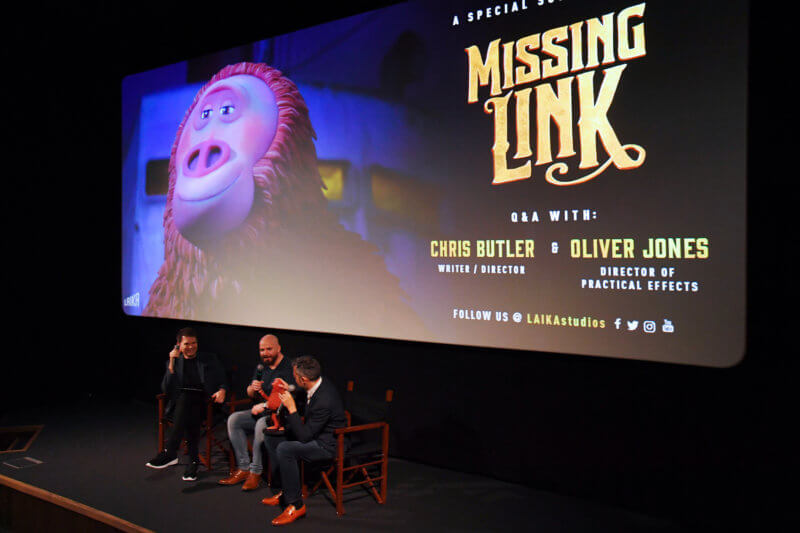
Chris Butler & Oliver Jones onstage at Missing Link & the Evolution of LAIKA (Image courtesy of WDW)
Which is the dream, isn’t it?
OJ: Yeah, we produced this stuff and even I can’t tell! I don’t know what scale something’s shot at, it all just blends together and the reference point of where you start it just gets lost. You’re just left with the movie, and that’s the most important thing. You’re left with the story and that’s what the audience should be taking away from it. Even though what we have is the very unique starting point we should hopefully have a unique ending.
CB: I think if an audience member is saying “what an amazing puppet”, we’ve not done our jobs. They should be saying “what an amazing character”, “what an amazing story”, hopefully! Then afterwards when we explain how it’s done, they can be amazed by the puppet. But while they’re watching the movie we want them to be in and compelled by that movie.
Sure! And is there something that you hope people will take away from the movie? It seems more aged-down than ParaNorman. Was there a conscious decision when you started developing it to do something a little bit softer, maybe a bit less scary than ParaNorman?
CB: That was as much a creative decision as anything. Because I – after ParaNorman – wanted to do something that was a bit visually and narratively different, just for my own selfishness. I wanted to try something else, I think because Travis [Knight] wants the studio to constantly be challenging itself. After Kubo I remember having this conversation with him where we were like, “You know, we’ve made four movies now with anguished 11-year-olds”, and it was like, here’s a project where the protagonists are anguished adults (who act like 11-year-olds) instead! That was one of the reasons why it seemed like the right thing to do. So I think yes, it had a different tone, it was definitely more playful than Kubo, a little softer. It was brighter, visually it was very different. I wanted to step out of the shadow of ParaNorman and do something that was bright, colourful and kaleidoscopic. So there was that – I think what this project presented was a change of pace. It presented us the chance to do something that we hadn’t done before.
Missing Link is available now on DVD and Bluray. To learn more about the film you can listen back to our podcast interview with director Chris Butler (Direct download or stream below) from earlier this year:


